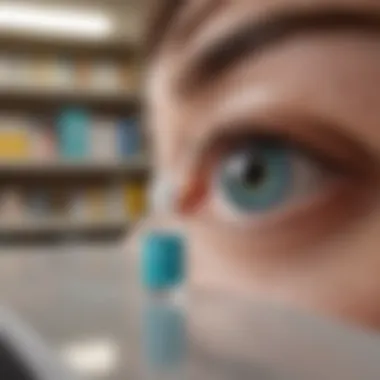The Impending Generic Availability of Restasis: Key Insights for Investors


Intro
The ongoing evolution in the pharmaceutical industry presents a significant opportunity for investors, particularly with the impending availability of generic Restasis. This medication, prescribed primarily for chronic dry eye, faces shifting dynamics in competition and pricing. Understanding the background and the potential effects of this change can help investors make informed decisions.
Through the analysis of market trends, stock performances, and the broader implications for the healthcare sector, readers can gain a nuanced perspective on how to approach investments related to Restasis' generic version.
Market Overview
Current Market Sentiment
The market sentiment surrounding pharmaceutical stocks is evolving. Recent developments indicate a cautious optimism among investors as they await the impending release of generic options for blockbuster drugs like Restasis. This sentiment is influenced by various factors, including FDA approvals, patent expirations, and the competitive landscape.
Major Indices Performance
Tracking major indices such as the S&P 500 and Nasdaq is crucial for understanding the overall market direction. The pharmaceutical sector, often resilient during economic downturns, has shown mixed results, buoyed by innovation but also challenged by pricing pressures and healthcare reforms.
Economic Indicators Analysis
Economic indicators play a pivotal role in shaping the investment strategies of individuals and institutions. Key metrics such as GDP growth, unemployment rates, and consumer spending can offer insights into how pharmaceutical stocks may perform once generic Restasis becomes available. Investors should pay attention to these indicators as they gauge market dynamics and risk factors in the sector.
Ending of Market Overview
Overall, the market presents both challenges and opportunities. By closely monitoring the indicators and broader sentiment, investors can better position themselves to capitalize on the upcoming changes in the pharmaceutical landscape.
Stock Analysis
Individual Stock Profiles
Examining stocks of companies involved in producing Restasis, such as Allergan, provides insights into their stability and growth potential. Investors must analyze each company's market position, pipeline products, and competitive advantages.
Historical Performance
Understanding historical performance trends is crucial. Stocks that were previously stable may face volatility as generics enter the market, which could affect pricing strategies and market share.
Valuation Metrics
Valuation metrics like price-to-earnings ratios and market capitalization give investors a snapshot of a company's worth. With the shift toward generics, these metrics may change rapidly and should be monitored closely.
Technical Analysis Insights
Technical analysis involves examining price movements and patterns to forecast future trends. Investors should utilize charts and historical data to identify potential entry and exit points, especially during the transition period following the generic release of Restasis.
Investment Strategies
Long-term vs.
Short-term Investments
Investors must determine their approach whether focusing on long-term hold strategies or short-term trading opportunities. Each strategy has its own merits and should align with individual financial goals and risk tolerance.
Diversification Techniques
To mitigate risk, diversification within and across different sectors can be beneficial. By spreading investments across various pharmaceutical companies, investors can cushion potential losses from any single stock.
Risk Management Practices
Implementing robust risk management strategies is vital. Investors should be prepared for market volatility and know how to set stop losses or exit strategies where necessary.
Recommended Asset Allocations
Each investor's portfolio should reflect their risk tolerance and investment horizon. Continued review and adjustment of asset allocations will ensure alignment with both market movements and personal finance goals.


Sector Analysis
Growth Sectors Overview
Pharmaceuticals, particularly in the area of generics, is a growth sector worth considering. As the release of generic medications like Restasis unfolds, the sector may witness increased competition and emerging companies exploring innovative treatments.
Sector-Specific Risks and Opportunities
Investing in pharmaceuticals presents unique risks, such as regulatory hurdles and patent wars. However, the opportunities for long-term growth driven by generics and lower healthcare costs also create a compelling case for investment.
Comparative Analysis among Sectors
Comparing pharmaceutical investments against other sectors can provide a clearer picture of overall market performance. Factors such as profitability, growth potential, and risk exposure can guide strategic decisions.
Emerging Trends in Specific Sectors
Emerging trends, such as innovations in biotech and personalized medicine, also warrant attention. These trends may influence the competitive landscape as the generic availability of Restasis impacts existing market players.
Financial Education Resources
Terminology and Concepts
Understanding key financial terms and concepts is essential for informed investing. Terms associated with pharmaceuticals, like patent cliff or bioequivalence, should become part of an investor's vocabulary.
Recommended Tools and Platforms
Investors can benefit from utilizing various tools and platforms for analysis. Websites like en.wikipedia.org and britannica.com provide valuable insights into industry trends, while platforms like reddit.com can offer investor perspectives and community discussions.
Learning Guides
For those new to investing, comprehensive learning guides can enhance financial literacy. Many resources are available both online and offline, tailored to different levels of investment experience.
Finale
As investors brace for the generic availability of Restasis, paying attention to market trends, stock analysis, strategic investments, and financial education becomes paramount. By understanding these dynamics, individuals can position themselves favorably in an evolving pharmaceutical landscape.
Preface to Restasis
The introduction of generic drug options often brings significant changes to the healthcare landscape, particularly for treatments like Restasis. The eye drops, which are primarily used to manage chronic dry eye, are known for addressing inflammation and improving tear production. As the generic availability of Restasis approaches, it is essential to understand its current positioning in the market, implications on pricing, and how it influences investor strategies.
Overview of Restasis and Its Functionality
Restasis, the brand name for cyclosporine ophthalmic emulsion, was developed to treat chronic dry eye by reducing inflammation. The active ingredient, cyclosporine, works by modulating the immune response to enhance tear production. The product is specifically designed for patients with insufficient tear production due to ocular inflammation. With the ongoing evolution of treatment options, understanding the specific functionality of Restasis is critical for investors. A deeper appreciation of how Restasis operates within the ocular health sector can highlight its potential value even as generics enter the market.
Patent Timeline and Exclusivity
The patent timeline for Restasis has played a significant role in its exclusivity and market dominance. Initially, Restasis was approved by the FDA in January 2003. Since then, its patent has undergone various reviews and extensions. Recent challenges, however, have eroded some of its market exclusivity. The last of its original patents expired in 2024, paving the way for generic formulation and competition.
Investors need to look at the implications of these patent expirations, as they can drastically influence the market landscape. The timeline of these patents gives insights into competitive dynamics and may help predict pricing changes and market share shifts as generic options become available.
Current Market Landscape for Restasis
The Current Market Landscape for Restasis carries significant importance for investors focusing on the shifts in the pharmaceutical sector. Understanding the market dynamics at play is essential, especially given that the introduction of a generic version of Restasis may affect stock performance for various companies involved in ophthalmic solutions. Trends in market share, consumer preferences, and competitor actions are critical elements to consider.
Overview of Restasis Market Share
Restasis, manufactured by Allergan, has maintained a respected position in the dry eye treatment market since its launch. It holds substantial market share due to its established efficacy and brand recognition.
- Sales Figures: Sales for Restasis have been consistent, often exceeding several hundred million dollars annually, showcasing its strong acceptance among patients.
- Market Segmentation: The primary market for Restasis includes patients suffering from chronic dry eye, often linked with inflammation due to conditions like Sjögren's syndrome or other autoimmune disorders.
- Market Growth: The market for dry eye medications shows growth potential. Aging populations and increased screen time have heightened awareness and the need for effective treatments.
"In the upcoming years, the market for dry eye therapies may expand significantly due to increasing demands from consumers."


Key Competitors in the Ophthalmic Market
As Restasis approaches the possibility of generic versions entering the market, it is imperative to look at its competitors. The landscape includes both established brands and newer entrants.
- Xiidra: Manufactured by Shire, Xiidra has emerged as a formidable competitor due to its unique mechanism of action targeting inflammation directly. Its market presence will likely affect Restasis sales if generics are introduced.
- Systane: This brand includes a variety of products aimed at relieving dry eye symptoms. Its diverse offerings can attract customers away from Restasis, especially if priced competitively.
- Nutritional Supplements: Products like HydroEye are gaining traction as alternative treatments, affecting traditional medication's market share.
In summary, the competitive landscape is dynamic and multifaceted. Investors should gauge how Restasis's market share will be impacted as generics emerge while considering the performance of its competitors. This information will be crucial for making informed investment decisions in the evolving landscape of ocular therapeutics.
When Will Restasis Go Generic?
The timing of Restasis going generic is vital information for investors. The introduction of generic versions can significantly impact the financial landscape of pharmaceutical companies and the broader market. The anticipation of generic availability influences stock prices, market dynamics, and consumer behavior. Investors should be aware of these elements to make informed decisions amidst these shifts.
Factors Influencing Generic Approval
Several factors play a crucial role in the approval process for generic medications like Restasis. Understanding these factors is essential for investors:
- Patent Status: The enforcement of existing patents is the primary barrier to generic entry. If current patents are solid, generic versions will face delays.
- Regulatory Agency Oversight: The FDA requires thorough testing and documentation before granting approval to generics. The regulatory landscape can often change, affecting the speed of approvals.
- Market Demand: High demand for Restasis can encourage more companies to seek approval for generics. This demand can also affect the strategies of existing competitors.
- Litigations: Ongoing legal disputes can delay or expedite the market entry of generics. Knowledge of current cases is vital for forecasting timelines.
“Generic approval hinges on multiple elements, including patents, regulatory oversight, and market dynamics, which collectively shape the pathway for Restasis generics.”
Expected Timeline for Generic Versions
The timeline for the release of generic Restasis is still developing. Several considerations shape expectations:
- Current Patents: Patents protecting Restasis expire in the near future. This expiration opens the door for generics, but not without drawbacks.
- FDA Approval Timeline: The FDA's review process can take several months to years. A quicker approval process has been seen in some cases, but each application is unique.
- Launching Generics: Once the FDA approves a generic, manufacturers must decide on launch timing based on market conditions and competition.
While some analysts predict that generic Restasis could enter the market by the end of 2024, others warn that various factors could delay this timeline. Investors must closely monitor these dynamics for impactful insights.
Impact of Generic Restasis on the Market
The impending availability of a generic version of Restasis significantly influences the pharmaceutical landscape. Investors must understand the nuances and ramifications of this shift. This section discusses key components, including pricing dynamics and corporate responses from established brands.
Price Dynamics with Generic Entry
As generic versions of Restasis become available, price competition is likely to escalate. During the transition from a brand-name product to generics, it is common for prices to experience a downward shift. This price drop occurs for several reasons:
- Increased Competition: Multiple suppliers can enter the market after patent expiration, contributing to lower prices.
- Consumer Choice: With more options, consumers can select less expensive generic alternatives, pressuring brand-name products.
- Insurance Coverage Adjustments: Insurers often favor more cost-effective generic medications, which can further inhibit sales of the brand product.
Investors need to recognize that while lower prices benefit consumers, they can create challenges for companies dependent on revenue from the brand-name Restasis. % If a significant drop occurs, this might affect their earnings directly.
Market Response from Competing Brands
The entry of a generic version of Restasis is sure to provoke reactions from competing brands in the ophthalmic sector. Companies that produce alternative dry eye treatments may adjust various strategies in anticipation of market changes. Key responses likely to unfold include:
- Adjusting Pricing Strategies: Competing brands may also lower their prices to attract consumers back, potentially impacting their profit margins.
- Enhanced Marketing Efforts: There might be a surge in advertising aimed at differentiating their products from generic versions. Establishing brand loyalty can be crucial in this phase.
- Product Development: Companies could invest in new formulations or delivery methods that enhance therapeutic effectiveness, appealing to a more discerning consumer base.
The shift toward generics in any medication often triggers significant changes across the market. Understanding how competitors react forms a crucial aspect in predicting future performance.
Overall, the impact of generic Restasis on the market stands to alter both pricing strategies and competitive positioning. Investors should keep a close eye on not only Restasis but also its competitors, as shifts in market dynamics could influence broader investment decisions.
Investor Considerations
Understanding the investor landscape regarding Restasis is crucial as the drug approaches generic availability. Investors need to assess several factors, including shifts in market value, competition dynamics, and potential investment opportunities. This section provides a detailed look at how the pharmaceutical sector could evolve and the implications this holds for those invested or looking to invest in related stocks.
Potential Stocks Affected by Restasis Generic Availability
The entry of generic Restasis into the market will likely disrupt the current stock landscape. Various companies could experience significant shifts in their financial outlooks.
- Allergan: As the original manufacturer of Restasis, Allergan will face immediate pressure. Should generic versions come to market, investors must watch for any possible stock depreciation.
- Competitors: Companies like Shire and Santen may benefit from this change. These firms produce alternative treatments for chronic dry eye. Any enhancement in their sales may lead to better stock performance.
- Generic Drug Manufacturers: Firms producing generics such as Mylan and Teva can expect growth. Their ability to capture market share will be vital for investors interested in generic pharmaceuticals.
The market will react based on early adopters and initial clinical efficacy of the generic offerings.


Overall, scrutinizing these stocks can provide insights into how the market positions itself in response to the generic version of Restasis.
Strategies for Investors Pre-and Post-Generic Release
Investors should consider specific strategies as they navigate the pre-and post-release phases of generic Restasis. Here are some effective approaches:
- Research Company Fundamentals: Before the release, focus on the financial health and market strategies of companies within the ophthalmic sector. This research will help determine viable investments.
- Adjust Portfolios Accordingly: If holding shares in Allergan, consider risk assessments. Shift investments towards generics or alternative treatments that might fare better with generic entry.
- Monitor Regulatory Changes: Keep an eye on the FDA’s decisions regarding approvals. Regulatory news can lead to swift market reactions.
- Engage in Trading Strategies: Use short selling for stocks expected to drop while looking for long positions in generics and competitors likely to thrive.
Regulatory and Legal Challenges
Understanding the regulatory and legal challenges surrounding Restasis is crucial for investors. The process of bringing a generic version of a drug to market is fraught with potential hurdles. These challenges can affect timelines, market dynamics, and ultimately, shareholder value. The interplay between patent protections, ongoing litigations, and FDA approvals directly influences the competitive landscape in the ophthalmic market.
Ongoing Patent Litigations
Patent litigations play a significant role in the availability of generic Restasis. The manufacturer of Restasis, Allergan, has aggressively defended its patents against generic challengers. Patent disputes can delay the entry of generics into the market, preserving brand exclusivity for longer periods than initially projected.
Currently, several companies are engaged in litigation or settlement discussions with Allergan. These activities can create uncertainty in the investment landscape. Investors need to pay attention to court rulings and any settlement announcements, as these can shift market perceptions significantly. Overcoming these legal barriers is crucial for generic companies looking to capitalize on Restasis' market potential.
The Role of the FDA in Generic Approval
The Food and Drug Administration (FDA) plays a key role in the generic drug approval process. To gain approval, a generic version of Restasis must demonstrate bioequivalence to the brand-name drug. This entails extensive testing and data submission. The speed and efficiency of the FDA's review process can dramatically influence how quickly generics become available to consumers.
The FDA's recent focus on increasing competition in the pharma sector means that it is likely to prioritize the approval of generic drugs. Investors should monitor FDA announcements, as the approval of a generic Restasis could come suddenly. Additionally, understanding the FDA's criteria for approval can provide insights into potential delays or fast-tracking processes related to Restasis.
Key Points: The legal and regulatory landscape is dynamic. Investors must stay informed about ongoing litigations and FDA activities. Both areas directly impact market conditions and potential investment strategies.
Consumer Perspectives
Understanding consumer perspectives is crucial in comprehending the overall market dynamics surrounding Restasis and its forthcoming generic version. Consumers, particularly patients who rely on Restasis for treating chronic dry eye, have unique experiences and expectations that can significantly influence market behavior. These perspectives can drive demand, affect pricing strategies, and ultimately shape the competitive landscape within the pharmaceutical sector.
Patient Experiences with Restasis
Patients using Restasis generally report varied outcomes. Some patients find relief from symptoms of dry eye due to inflammation, which enhances their quality of life. The efficacy of Restasis is often attributed to its active ingredient, cyclosporine A, which helps to increase tear production when inflammation occurs in the eyes. However, not all patients respond positively.
The patient experience with Restasis can involve several aspects:
- Treatment Regimen: Individuals must adhere to a strict regimen, which often requires them to use the drops twice daily. This can sometimes be cumbersome and lead to non-compliance.
- Side Effects: Some users report side effects such as burning and stinging upon application, which can deter continued use.
- Cost Concerns: As a prescription medication, Restasis can be expensive, particularly for those without insurance. Patients may be eager for a generic version to alleviate this financial burden.
The diverse nature of patient experiences highlights the need for investors to consider not just sales data but also patient satisfaction and feedback.
Expectations for Generic Restasis
As the introduction of generic Restasis approaches, stakeholders across the healthcare landscape are waiting with anticipation. The expectations for generic Restasis are shaped by several factors, including:
- Cost Reduction: Patients and healthcare providers expect the price of treatment to drop significantly. A generic alternative is likely to be more affordable, making it accessible to a broader audience.
- Market Penetration: Historically, generic versions can rapidly gain market share, challenging the established brand. Investors should monitor how quickly generic options become available to consumers.
- Patient Switching Behavior: There is an expectation that existing users of branded Restasis may switch to the generic version. This transition could influence the overall market dynamics.
The End
The importance of the conclusion in this article cannot be understated. It provides a critical synthesis of the various discussions that have unfolded regarding the impending generic availability of Restasis. This section highlights essential insights that investors need to grasp in a rapidly changing market environment.
Summary of Key Insights
Investors must be aware of several takeaways from the emergence of generic Restasis. First, the dynamics of price competition are expected to intensify, leading to reduced costs for consumers. The introduction of generic alternatives usually results in a marked decrease in the price of the original branded product. This offers both benefits and challenges for those involved in stock investments within the pharmaceutical sector.
Another pivotal insight is the timeline associated with the expected approval of generic versions. As indicated earlier in the article, various factors influence this timeline—including ongoing patent litigations and the role of regulatory bodies like the FDA.
Finally, understanding the competitive landscape is crucial. With new entrants into the ophthalmic market, existing players will likely adjust their strategies, potentially affecting stock performances and market shares across the board.
Future Outlook for Restasis and Market Trends
The future outlook for Restasis in a generic landscape appears complex. As generic versions become available, market trends may shift significantly. Investors should monitor competitor responses closely as they may innovate to retain market share or compete on pricing.
Observing the stock performances of companies affected by Restasis will require a nuanced approach. Experienced investors might consider diversifying their portfolios to buffer against any volatility introduced by the new generics.
In addition, regulatory updates will remain a critical focal point. Keeping abreast of FDA announcements and patent litigation outcomes could yield vital insights that inform investment decisions. Investors must stay vigilant, as the pharmaceutical market often reacts unpredictably.
In a nutshell, while generic Restasis presents both opportunities and risks, it is essential to adopt a well-informed strategy that accounts for these variables.



